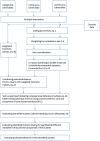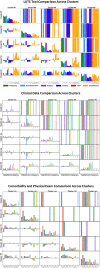Subtyping of common complex diseases and disorders by integrating heterogeneous data. Identifying clusters among women with lower urinary tract symptoms in the LURN study
- PMID: 35687541
- PMCID: PMC9187122
- DOI: 10.1371/journal.pone.0268547
Subtyping of common complex diseases and disorders by integrating heterogeneous data. Identifying clusters among women with lower urinary tract symptoms in the LURN study
Abstract
We present a methodology for subtyping of persons with a common clinical symptom complex by integrating heterogeneous continuous and categorical data. We illustrate it by clustering women with lower urinary tract symptoms (LUTS), who represent a heterogeneous cohort with overlapping symptoms and multifactorial etiology. Data collected in the Symptoms of Lower Urinary Tract Dysfunction Research Network (LURN), a multi-center observational study, included self-reported urinary and non-urinary symptoms, bladder diaries, and physical examination data for 545 women. Heterogeneity in these multidimensional data required thorough and non-trivial preprocessing, including scaling by controls and weighting to mitigate data redundancy, while the various data types (continuous and categorical) required novel methodology using a weighted Tanimoto indices approach. Data domains only available on a subset of the cohort were integrated using a semi-supervised clustering approach. Novel contrast criterion for determination of the optimal number of clusters in consensus clustering was introduced and compared with existing criteria. Distinctiveness of the clusters was confirmed by using multiple criteria for cluster quality, and by testing for significantly different variables in pairwise comparisons of the clusters. Cluster dynamics were explored by analyzing longitudinal data at 3- and 12-month follow-up. Five clusters of women with LUTS were identified using the developed methodology. None of the clusters could be characterized by a single symptom, but rather by a distinct combination of symptoms with various levels of severity. Targeted proteomics of serum samples demonstrated that differentially abundant proteins and affected pathways are different across the clusters. The clinical relevance of the identified clusters is discussed and compared with the current conventional approaches to the evaluation of LUTS patients. The rationale and thought process are described for the selection of procedures for data preprocessing, clustering, and cluster evaluation. Suggestions are provided for minimum reporting requirements in publications utilizing clustering methodology with multiple heterogeneous data domains.
Conflict of interest statement
The authors have declared that no competing interests exist.
Figures









Similar articles
-
Phenotyping Men With Lower Urinary Tract Symptoms: Results From the Symptoms of Lower Urinary Tract Dysfunction Research Network.Neurourol Urodyn. 2025 Jan;44(1):178-193. doi: 10.1002/nau.25596. Epub 2024 Oct 7. Neurourol Urodyn. 2025. PMID: 39370868 Free PMC article.
-
Symptom Based Clustering of Women in the LURN Observational Cohort Study.J Urol. 2018 Dec;200(6):1323-1331. doi: 10.1016/j.juro.2018.06.068. Epub 2018 Jul 7. J Urol. 2018. PMID: 29990467 Free PMC article.
-
Longitudinal changes in symptom-based female and male LUTS clusters.Neurourol Urodyn. 2020 Jan;39(1):393-402. doi: 10.1002/nau.24219. Epub 2019 Nov 25. Neurourol Urodyn. 2020. PMID: 31765491 Free PMC article.
-
EAU Guidelines on the Assessment of Non-neurogenic Male Lower Urinary Tract Symptoms including Benign Prostatic Obstruction.Eur Urol. 2015 Jun;67(6):1099-1109. doi: 10.1016/j.eururo.2014.12.038. Epub 2015 Jan 19. Eur Urol. 2015. PMID: 25613154 Review.
-
Urinary Symptoms and Bladder Voiding Dysfunction Are Common in Young Men with Defecatory Disorders: A Retrospective Evaluation.Dig Dis Sci. 2022 Jul;67(7):3036-3044. doi: 10.1007/s10620-021-07167-z. Epub 2021 Jul 22. Dig Dis Sci. 2022. PMID: 34292471 Review.
Cited by
-
Dynamic analysis of the individual patterns of intakes, voids, and bladder sensations reported in bladder diaries collected in the LURN study.PLoS One. 2023 Nov 20;18(11):e0284544. doi: 10.1371/journal.pone.0284544. eCollection 2023. PLoS One. 2023. PMID: 37983243 Free PMC article.
-
Overactive Bladder Syndrome: The Urgency of Integrating Emerging Methodologies to Improve Therapeutic Outcomes.Int Urogynecol J. 2024 Sep;35(9):1731-1733. doi: 10.1007/s00192-024-05939-5. Epub 2024 Sep 14. Int Urogynecol J. 2024. PMID: 39276280 No abstract available.
-
Revealing chronic disease progression patterns using Gaussian process for stage inference.J Am Med Inform Assoc. 2024 Jan 18;31(2):396-405. doi: 10.1093/jamia/ocad230. J Am Med Inform Assoc. 2024. PMID: 38055638 Free PMC article.
-
Phenotyping Men With Lower Urinary Tract Symptoms: Results From the Symptoms of Lower Urinary Tract Dysfunction Research Network.Neurourol Urodyn. 2025 Jan;44(1):178-193. doi: 10.1002/nau.25596. Epub 2024 Oct 7. Neurourol Urodyn. 2025. PMID: 39370868 Free PMC article.
References
-
- Irwin DE, Milsom I, Hunskaar S, Reilly K, Kopp Z, Herschorn S, et al.. Population-based survey of urinary incontinence, overactive bladder, and other lower urinary tract symptoms in five countries: results of the EPIC study. Eur Urol. 2006;50(6):1306–1314; discussion 1314–1305. doi: 10.1016/j.eururo.2006.09.019 - DOI - PubMed
Publication types
MeSH terms
Grants and funding
LinkOut - more resources
Full Text Sources
Other Literature Sources
Medical

